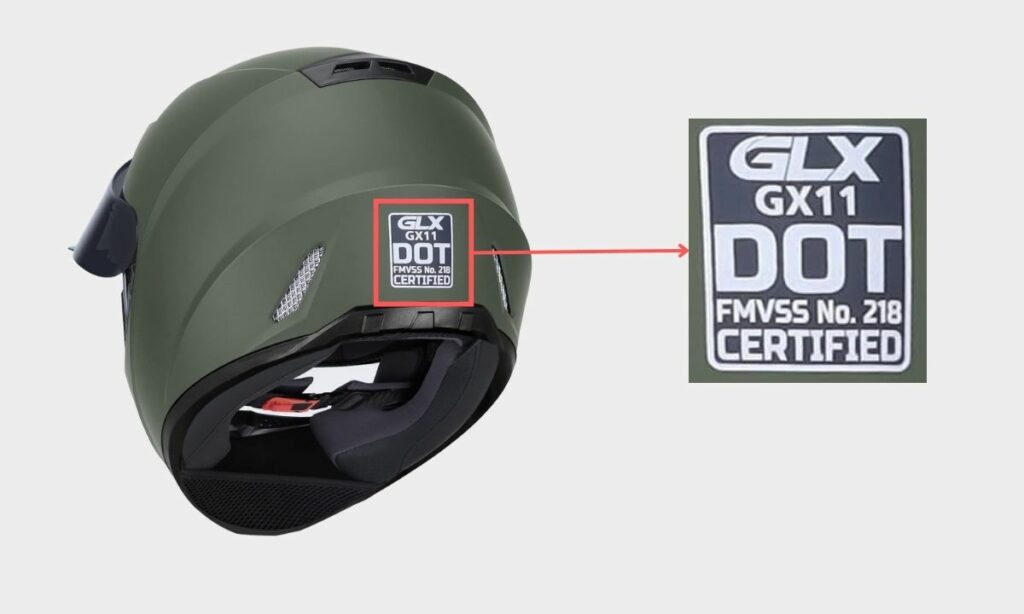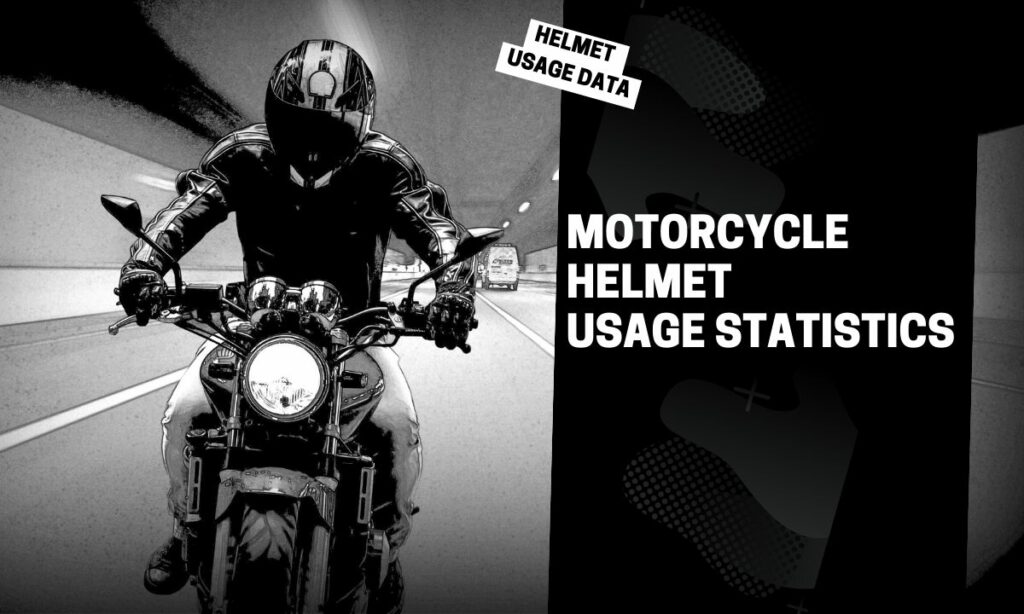This is a complete list of motorcycle helmet usage statistics in the United States.
In this statistic roundup, we will discuss:
Helmet usage over the decade, helmet types used, usage in states with different helmet laws, and helmet usage across different regions, road conditions, and traffic conditions.
We also look at the effectiveness of the helmets in crashes and what the data says.
So, without further ado, let’s dive right in:
Key Helmet Usage Statistics (Editors’ Picks)
- In the United States, 66.5% of motorcycle riders used helmets (DOT-compliant) for the year 2022.
- 67% of motorcyclists were using DOT-compliant helmets, 9% were using non-compliant helmets, and 24% were not wearing helmets at all.
- 18 states in the US have laws mandating helmets for all motorcyclists. 29 states have partial helmet requirements applicable only to a subset or certain age groups. And 3 states have no motorcycle helmet requirements.
- For the year 2022, 92.8% of motorcyclists used helmets in states that mandate helmet usage for all riders. The helmet usage in other states was only 63.6%.
- The helmet usage is the highest in the West with 96.8% of motorcyclists wearing helmets. The lowest is in the Midwest region (52%).
- Motorcycle helmet usage is higher on expressways (88%) than on the surface streets (69%).
- Motorcyclists tend to use helmets more with high-speed traffic.
- Helmets are 37% effective in preventing fatalities for motorcycle riders and 41% for motorcycle passengers.
Helmet use trend over the decade
The motorcycle helmet use in the United States has been more or less the same in the last decade. With a slight uptick in usage.
In the survey conducted by National Occupant Protection Use Surveys (NOPUS) for NHTSA (National Highway Traffic Safety Administration), helmet usage in the US is detailed in the chart below.
For the year 2022, motorcycle helmet usage in the US was 66.5% (DOT-compliant helmets).
The usage has increased when compared over a decade. In the year 2012, the motorcycle helmet use was 60.4%.
But, when compared to the years between 2018 to 2020, helmet use has slightly reduced.
Again, to reiterate, these are survey results NOPUS conducted for NHTSA.
The survey results can differ from the actual results.
Do helmets save lives? – Safety statistics for helmets
Helmets definitely save lives.
According to NHTSA, helmets are 37% effective in preventing fatalities to motorcycle riders and 41% for motorcycle passengers.
In short, for every 100 motorcycle riders killed in crashes while not wearing
helmets, 37 of them could have been saved had all 100 worn helmets.
NHTSA reported that the use of motorcycle helmets saved an estimated 1,872 lives in 2017.
Furthermore, an additional 749 lives could have been saved if all the
motorcyclists had worn helmets.
For more info on accidents, you can check out the statistic round-up on motorcycle crashes we have put together.
Motorcyclists by Helmet type
Not all motorcyclists were using DOT-compliant helmets according to the NHTSA survey.
There was a significant usage of non-compliant helmets as well.
For the year 2022, 67% of motorcyclists were using DOT-compliant helmets, 9% were using non-compliant helmets, and 24% were not wearing helmets at all.
Compared to 2012, the use of DOT-compliant helmets has gone up whereas the non-compliant helmet usage has remained stagnant.
Broadly speaking, the shift from no helmets to helmets has invariably resulted in the use of DOT-compliant helmets rather than non-compliant helmets.
For those wondering about DOT:
DOT-compliant helmets are helmets that meet the standards set by Federal Motor Vehicle Safety Standard – 218 (FMVSS No. 218).
The helmet manufacturers have to self-certify their helmets complying with the FMVSS standards.
How do you know whether a helmet is DOT-compliant?
DOT-compliant helmets have a label on the back containing the manufacturer or the brand name and DOT-certified label.

You can clearly see the ‘DOT’ and ‘FMVSS No. 218 certified’ labels on the back of the helmet.
How many states have helmet laws?
Not all states in the United States have laws mandating helmets.
Helmet laws in the US are different from one state to another. Different states have their own state laws regarding helmet usage.
So, in how many states in the US helmets are mandatory for all motorcyclists?
There are 18 states wherein using helmets is mandatory for motorcyclists.
In 29 states, helmets are required only for certain age groups of motorcycle riders (under the ages of 17, 18, or 21).
And in 3 states – Illinois, Iowa, and New Hampshire – there are no motorcycle helmet requirements.
These are the 18 states where helmet usage is mandatory for all motorcycle riders:
| States requiring helmets for all motorcyclists |
|---|
| Alabama |
| California |
| Georgia |
| Louisiana |
| Maryland |
| Massachusetts |
| Mississippi |
| Nebraska |
| Nevada |
| New Jersey |
| New York |
| North Carolina |
| Oregon |
| Tennessee |
| Vermont |
| Virginia |
| Washington |
| West Virginia |
The rest of the states (excluding Illinois, Iowa, and New Hampshire) have laws where helmets are required only for a subset of motorcycle riders. Mostly the subset applied basis the age groups.
Helmet usage by state laws
Motorcycle helmet usage is higher in states that require all motorcyclists to use helmets than the other states.
This comes as no surprise.
For the year 2022, 92.8% of motorcyclists used helmets (81.5% DOT-compliant and 11.3% non-compliant) in states that mandate helmet usage for all riders.
Compare that to other states.
States where there are no state laws or laws mandating helmets only for small groups of motorcycle riders (mostly for age groups below 17, 18, or 21).
The helmet usage in these states was only 63.6% (56.2% DOT-compliant and 7.4% non-compliant).
Motorcycle helmet usage by region
The NHTSA survey used the following geographic regions to segment helmet usage by US regions:
- Northeast
- Midwest
- South
- West
The states defined under each of these regions are mentioned in the chart below.
The helmet usage is the highest in the West with 96.8% of motorcyclists wearing helmets.
Whereas the Midwest has the lowest % of motorcyclists wearing helmets (52%).
The low helmet usage in the Midwest can be correlated with the State laws not mandating helmets for all motorcycle riders.
Compare that with the West and the Northeastern states. Most of the states in these regions have helmet usage compulsory for all motorcyclists.
The correlation between the state laws and helmet usage can clearly observed here.
Motorcycle helmet usage by road conditions
Motorcycle helmet usage is higher on expressways (88%) than on the surface streets (69%).
This is a no-brainer.
Yet, it reinforces how motorcyclists view road risks and use helmets for safety measures in different road conditions.
Also. DOT-compliant helmets are the goto helmets on expressways.
Non-compliant helmets on expressways is only 5% whereas its share on surface streets is 10%.
Motorcycle helmet usage by traffic
Motorcyclists tend to use helmets more with high-speed traffic.
Again, these statistics make complete sense.
With high-speed traffic conditions, riders get more safety concerned.
As a result:
Helmet usage is the highest on fast traffic conditions (81%) and the lowest on slow traffic (65%).
Even on medium-speed traffic, the helmet usage is pretty high (77%).
FAQs
While there is no set expiry date for helmets, a thumb rule of 5 years is a good helmet replacement rule. Over time helmets face wear and tear, and technology obsolescence.
Illinois, Iowa, and New Hampshire – are the only 3 states in the US where there are no motorcycle helmet requirements. Other states have either mandatory or partial helmet usage laws.
Yes. Helmets definitely make motorcycle riding safer. NHTSA estimates helmets are 37% effective in preventing fatalities for motorcycle riders and 41% for motorcycle passengers.
Final Words
That’s the wrap-up on helmet usage statistics in the US.
We wanted to put this list of stats together to improve helmet awareness among motorcycle riders and its role in motorcycle safety.
No matter how you slice it, motorcycle helmets are important for rider safety.
In addition, we have also put together a few more statistic roundup:
